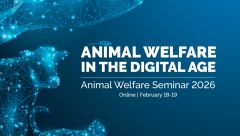As we look back on 2022 at the RSPCA, we’re pleased to see progress has been made on one of our longest-running advocacy priorities – securing an end to the cruel and unfixable live sheep export trade.
At the start of the year in January, we saw new polling that once again confirmed more than 2 out of 3 Australians still want to see an end to live export. This was a sobering reminder that to continue this practice would be against the wishes of the Australian community, no matter where they live – opposition stretched far and wide, including 2 out of 3 people in rural or country areas, and almost 3 in 4 Western Australian (where the majority of Australian sheep are currently exported from).
We also started the year concerned that the former Federal Government was considering winding back the hard-won northern summer prohibition (implemented after the disastrous Awassi Express in 2017) as part of its regulatory review of live sheep export by sea to, and through, the Middle East. While we can now confirm that the government does not intent to wind-back the prohibition period, the review reinforced just how cruel and problematic this trade is.
And this deep concern was reflected throughout the federal election campaign. As the nation geared up for the May election, we were pleased to see animal welfare on the agenda, and particularly heartened to see the Australian Labor Party reaffirm its commitment to a phase out of live sheep export, if elected – a continuation of the policy they took to the election in 2019.
As we said at the time, with a number of political parties maintaining support for a phase out of live sheep exports from the last federal election to the present, this volatile and disaster-plagued industry’s days are predictably and clearly numbered. In the meantime, we are gearing-up to continue our campaign to legislate the end of live sheep exports in this term of government and will not stop until the trade ends.
Let’s take a moment to reflect on why live sheep export is such a key issue for us.
A trade built on unacceptable suffering
While the live export of sheep for slaughter from Australia is a practice that has been in terminal decline for some years now, it still continues to this day. This is despite contemporary animal welfare science proving the very basic welfare needs of sheep cannot be met or protected on live export vessels and they suffer poor welfare as a result.
Long-haul journeys subject sheep to extreme temperatures resulting in heat stress, further compounded by overcrowded stocking densities which prevent them from comfortably laying down and impeding the ease of access to food and water. These conditions can also obstruct identifying sick or injured sheep, leaving those missed suffering and at risk of a drawn-out death. Pen infrastructures aboard ships were constructed in the 1970’s and concerningly, little has changed in the fifty years since.
The lack of bedding or manure removal on voyages is also a grave concern, not only putting sheep at risk of lameness and disease, but with rising temperatures and humidity onboard the manure can form a thick dense layer of sludge, bogging sheep down where if unassisted, they will die trapped in their own waste.
Sheep who survive these perilous journeys face further welfare risks at their countries of destination. Australian laws and welfare standards do not protect sheep once they disembark, and extensive evidence gathered from importing countries has shown time and time again the occurrence of inhumane slaughter and handling practices in international ports.
The live export industry measures the welfare success of their voyages primarily by the number of sheep that die, a poor and overwhelmingly discredit measure that fails to account for the number of animals that suffer terribly but survive. It’s a grim indication of the live export industry’s focus, when the key measure of success is that animals don’t die yet experience terrible welfare on the journey and at the international destination.
Crucial point for change – where to in 2023?
The good news is, we are at a pivotal point for change. We have the most tangible chance in years to improve the welfare of hundreds of thousands of vulnerable sheep who face the risk of being exported from Australia every year.
But to ensure this happens, the Federal Government must legislate an end date for live sheep export as soon as possible in this term of Parliament – in other words, before the next federal election in 2025.
This is clearly the right decision – as far back as 1985, the Senate Select Committee on Animal Welfare concluded the trade should be discontinued on welfare grounds. Since then, two separate government reviews (Keniry Review 2003; Farmer Review 2011) have indicated that that the mortality rates of sheep exported into the Middle Eastern summer are unacceptably high. And despite industry's best attempts, these issues remain unfixable. Just recently we learned that even under the current intense scrutiny, sheep being exported from Australia right now continue to face terrible conditions. Ending the trade is not a new idea, the United Kingdom has already banned the practice and New Zealand will cease live animal export altogether in April next year. Continuing live sheep export risks tarnishing Australia’s international reputation, not to mention the impact on Australian farmers trapped in an unsustainable industry.
So where to from here? Here at the RSPCA, we believe it’s crucial that the Australian Government must set an end date for the phase out before 2025 – read our blog to find out why in more detail. We will continue to advocate this and ensure an end to the trade – and if 2022 has taught us anything, it’s that this is the only outcome the community will accept.







